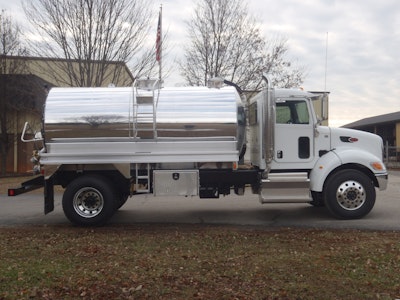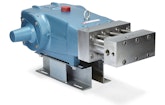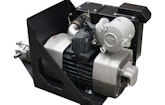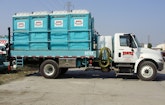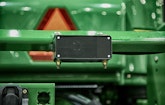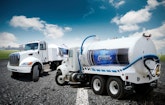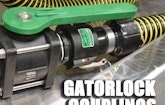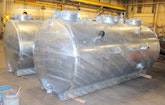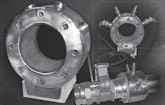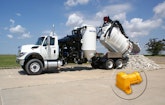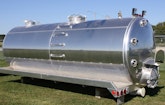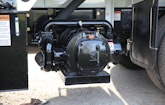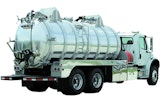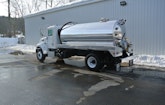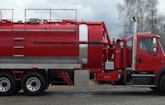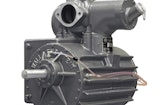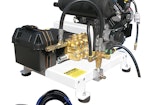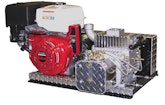Interested in Trucks?
Get Trucks articles, news and videos right in your inbox! Sign up now.
Trucks + Get AlertsWhen you’re looking to buy a new pumper truck, Jay Minear has a few words of advice: More — in terms of things like more tank capacity, more horsepower and a more powerful vacuum pump — definitely is better.
Why? It allows pumpers to do jobs faster, which equates to higher profitability; it reduces strain on components; and enables them to do more kinds of work, which helps diversify their business base, says Minear, a sales representative for Keith Huber Corp. and a 17-year veteran of the pumping industry.
“I know it sounds like a salesman talking, but I know from general experience that more power and capacity is better,” Minear says. “You can pay around $100,000 for a vacuum truck that’s limited in what it can do. Or you could spend $150,000 to $160,000 for a well-equipped truck with, say, a 3,300-gallon tank, a 300-gallon water tank, a 35 gpm/2,000 psi water pump and a 440 cfm vacuum pump.
“That truck is set up to do almost anything you want to do, from pumping septic tanks and grease traps to cleaning municipal sewer lines to doing industrial cleaning,” he adds. “Guys ask me all the time what they can do with a well-equipped vacuum truck, and I just tell them, ‘Use your imagination.’”
Speccing out a truck properly depends on a wide variety of variables. As Minear notes, virtually every pumper operates under different conditions that can affect a truck’s requirements — things such as the price they pay for waste disposal, how far away waste-treatment centers and customers are located and the terrain in which they travel. But even with all that in mind, there are still some basic things to consider, as Minear explains.
Fill ‘er up
Minear recommends getting a larger tank, starting with a minimum of 3,000 to 3,300 gallons. Why? For one, there’s a general trend toward larger aerobic tanks, which in turn dictates a need for larger tanks. In addition, larger tanks decrease the amount of disposal trips required, which saves fuel and time, boosts productivity and minimizes truck wear-and-tear. “If you travel a lot of miles, you want as much tank capacity as possible to make it more economical,” Minear says.
Pumpers should also think about unexpected business developments that could arise that require a larger tank, such as entering the market for grease-trap cleaning (he says a typical restaurant grease trap holds 1,000 gallons) or acquiring new customers that live farther afield.
Steel’s the deal
While carbon steel and aluminum tanks both offer advantages, Minear says he prefers steel because it’s less vulnerable to corrosion and handles stress and strain better than aluminum.
Some drivers prefer aluminum because it’s lighter, which allows them to buy a larger tank and still meet road weight restrictions. But Minear notes that by simply speccing a tri-axle configuration — or even quad-axle — a pumper can carry a larger tank and still meet weight restrictions because the extra axles distribute the weight more evenly.
A tri-axle setup might cost about $7,000 to $10,000 more than a conventional dual-axle configuration, and a quad-axle setup can cost about double those figures. “But it’s a small price to pay for an expensive overload ticket,” he says.
Another point to ponder: Minear suggests spending roughly $10,000 more to get an ASME/DOT-certified tank that can legally carry hazardous waste. “I like ASME/DOT-code tanks for one simple reason — resale value,” Minear says. “It’s easier to sell a code tank because there’s no limit to what the buyer can haul plus you can make more money by serving different markets.”
Jetter is better
Adding a water jetter, a 300-gallon water tank and a water pump (35 gpm at 2,000 psi) to a rig can cost about $20,000. Or you could spend around $13,000 to $14,000 for a less powerful pump (10 gpm at 2,000 psi). But either way, Minear says it’s an investment that can quickly pay for itself, both in terms of enhancing customer service and adding another revenue stream for jetting services.
“If you’re cleaning a septic tank and the homeowner says the line is running slow, or you’re cleaning a grease trap and a restaurant owner says a trunk line is running slow, you can put a nozzle on the end of the hose and clean them out,” Minear says.
Moreover, customers appreciate not having to call another contractor and wait longer to get the line cleaned. “Plus, if you’re cleaning a septic tank that hasn’t been pumped in 40 years, you can use that jetter to literally cut solid debris off the walls of the tank. Sometimes it’s the difference between doing it in half an hour or standing there for four hours.”
Rev it up
Minear suggests speccing nothing less than a 350 hp diesel engine; personally, he prefers a 425 hp engine, which costs about $8,000 to $10,000 more than the smaller engine. But a more powerful engine handles a heavy load better and puts less stress on the chassis and tank. The gas mileage for a 350 hp engine versus a 425 hp engine is negligible, so that isn’t a factor, he points out.
“With a larger engine, you don’t have to wind it up or use all its power to make it work,” he explains. “That also relieves strain on the engine and the overall system. Remember, these trucks have a lot of hydraulics to run that take horsepower, like the vacuum pump and the jetter’s water pump, so it’s better to go bigger.”
Shift work
When it comes to transmissions, Minear believes in the KISS philosophy: Keep It Simple, Stupid. In other words, save some money and spec an eight- or 10-speed manual transmission versus an automatic transmission. The price difference between manual and automatic is about $10,000 to $13,000, Minear says.
“Lots of guys spend a lot of money on automatic transmissions because they can’t find drivers who can drive a stick shift, but manual transmissions are a lot easier to use these days,” Minear says. “Sometimes guys want more gears to handle bigger loads, but I’d never recommend an 18-speed transmission, or even a 13-speed because I prefer simplicity. If you’ve got enough horsepower up front, the transmission will cover it.”
Pump it up
Minear says both water-cooled and air-cooled pumps can serve pumpers well, but he prefers liquid-cooled pumps, which he says he’s run for up to 12 hours straight without any problems.
Open-door policy
Minear also suggests investing in two other options: a hydraulic tilt tank and a full-open rear door. This feature costs about $7,000 to $15,000, but can pay for itself by dramatically reducing dumping and tank cleaning time, he says.
“Again, if you’ve cleaned a tank that hasn’t been pumped in 40 years, you’re going to deal with some awfully thick, gooey stuff that’ll be a bear to off-load without a full-lift tank,” he notes. “You’ll be working like a dog to get the tank washed out with a garden hose or whatever else is available. This is where a truck-mounted jetter also comes in handy.”
The bottom line when speccing out a vacuum truck: It’s better to go bigger because it gives operators the versatility to do more kinds of work — and do it more efficiently, too.
We’ve got you covered. Check out this gold mine of vacuum pumps, tanks, components and basically anything you need to spec out your ultimate septic truck.
- Heated collars from L. T. & E. keep valves from freezing. Made of 304 stainless steel, collars are available in 3-, 4- and 6-inch sizes.
- The DV12KVL Dump Box Vibrator from Del Hydraulics vibrates sticky loads and moves material out quickly and cleanly.
- Doran Manufacturing’s 360 tire pressure monitoring systems help to minimize tire repair and maintenance costs for fleets by providing drivers with real-time tire pressure information and critical low-pressure alarms.
- The Jurop RV360 rotary vane vacuum pump from Jurop/Chandler offers efficient, dual-fan cooling technology and quiet operation.
- The Earth Shuttle truck-mounted wet/dry vacuum loader from Fast-Vac can accommodate a roll-off truck that does not require a dedicated chassis, reducing overall investment.
- Preassembled vacuum pump packages from Moro USA are offered for all air-, fan- and liquid-cooled W-Series vacuum pumps, and are available in standard perch-mount and close-coupled orientation.
- The PV750 rotary vane pump from Presvac Systems is designed for continuous full vacuum operation in extreme conditions.
- The Bolt and Go from Surpresseur 4S Inc. features a range of Robuschi RB-DV 28-inch Hg high-vacuum blowers from 500 to 2,600 cfm.
- The Patriot 300 ballast-port-cooled, continuous-duty pump from VARCo offers over 300 cfm of vacuum.
- The 753 Series vacuum pump from Wallenstein Vacuum Pumps incorporates extra-wide vanes that allow up to an inch of wear, resulting in longer service life with lower maintenance costs.
- Conde Powerpak preassembled, gasoline- or diesel-powered vacuum pump units from Westmoor Ltd. are installed by simply bolting them down and attaching them to the tank.
- The model 6810 triplex plunger pump from Cat Pumps offers a flow rate of 10 gpm and pressure to 10,000 psi at 600 rpm.
- GatorLock Couplings from Green Leaf allow for the quick connect and disconnect of tanks, pumps, transfer lines and more.
- Tigerflex Amphibian AMPH Series heavy-duty polyurethane-lined wet or dry material handling hose from Kuriyama of America has high abrasion resistance, with a polyurethane liner designed to resist internal wear, especially in the hose bends.
- The 4,000-gallon aluminum Matador septic/grease vacuum tank from Amthor International comes standard with a 5/16-inch-thick side shell and floor, full head baffles and no external rings.
- The All-In-One Rectangular Vacuum Tank from Crescent Tank Mfg. is a low-profile flat vacuum tank with the versatility of transporting several portable restrooms at one time, hand-wash stations, additional water tanks or other equipment.
- VST Series truck-mount vacuum service tanks from Glendale Industries are constructed with a thick carbon steel shell, welded seams inside and out and a powder-coat finish to combat corrosion.
- Hot-dip galvanized vacuum tanks from LMT – VAXTEEL combat steel corrosion in harsh environments.
- The 400-gallon aluminum vacuum tank from Mid-State Tank Co. comes with 20-inch top and rear manways, primary, three 5-inch sight eyes and more.
- The ASME 407/412 carbon steel full rear-open hoist and door from Progress Tank is available in carbon steel, stainless steel and aluminum, all in ASME, non-code, DOT and TC.
- The 2,500-gallon septic/grease vacuum tank from Robinson Vacuum Tanks comes standard with a polished aluminum shell, full flanged and dished anti-surge baffles and more.
- The Ecolo-filter ACF from TEAMCO separates liquids and solids by filtering the whole septic tank at once.
- The TD80 liquid level gauging system from Titan Logix Corp. uses guided wave radar to measure the liquid level or volume in mobile tanks.
- Industrial-grade skid-mounted pressure washers from Water Cannon have 10,000-hour rated Gates poly-chain cogged belts, an easy-start feature, an adjustable pressure unloader and an engine oil drain.
- Thermaflow mobile hydraulic coolers from STAC Inc. serve as the heart of a truck hydraulic system.
- Martin Engineering’s Cougar line of vibrators improves off-loading of industrial waste from vacuum loaders, hydroexcavators and sewer cleaners.
- The S6TDI 6-inch vortex impeller submersible trash pump from Hydra-Tech Pumps has a fully recessed stainless steel impeller and passes large solids, stringy materials and slurries with entrained gases.
- Multi-Frequency Alarms (MFA) from ECCO Safety Group are designed for confined or densely populated work areas because their sound dissipates more quickly than pure tone alarms.
- The two-disc pneumatic clutch from Logan Clutch Corporation provides a significant amount of torque, requires no adjustment and can be activated by a push button in the heated cab whenever needed.
